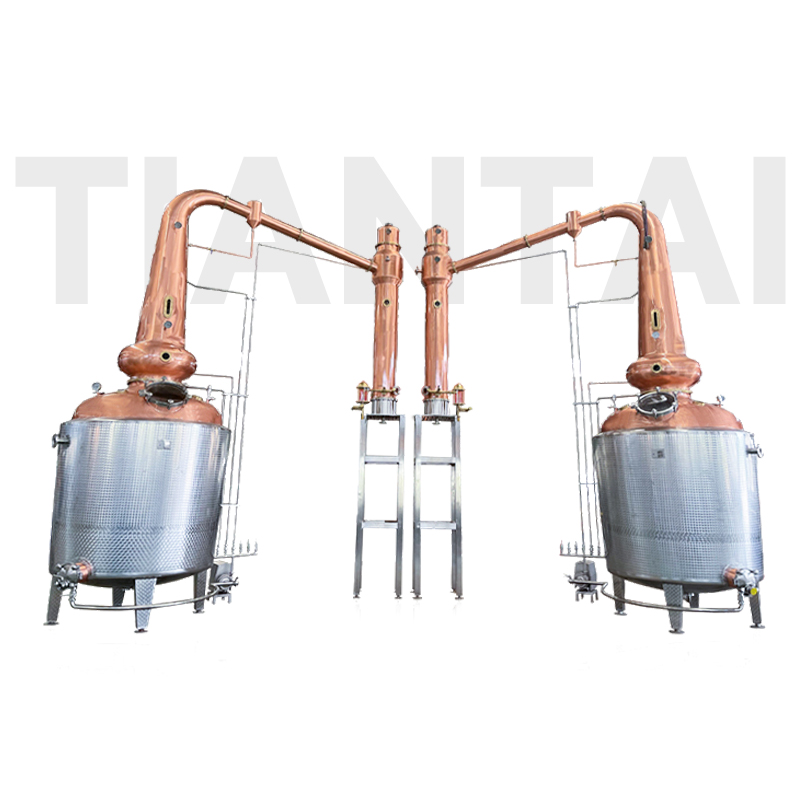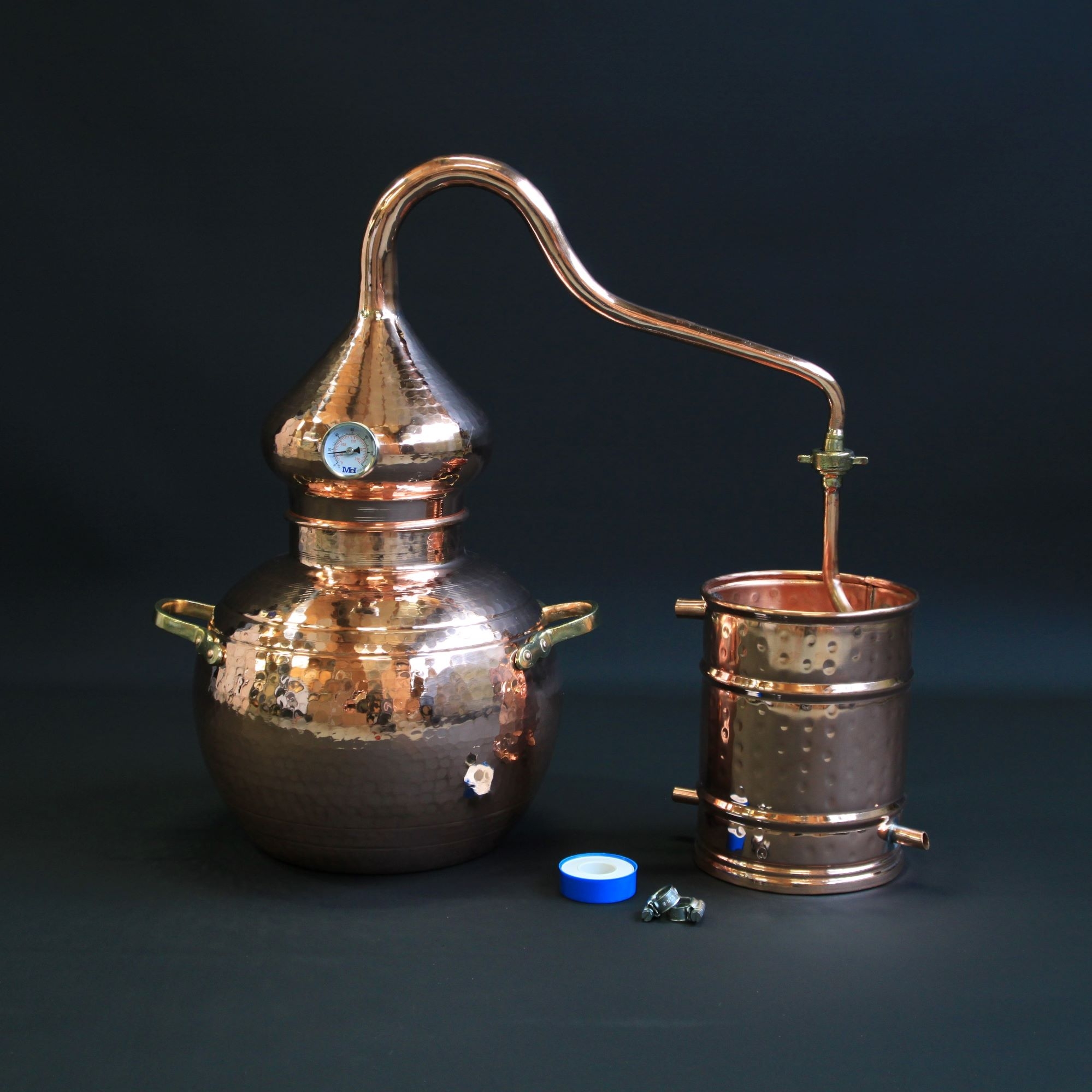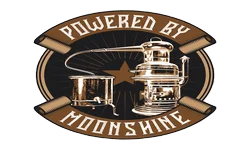Why Distill Moonshine Twice? Answering a Common Distilling Question

Key Takeaways
- Double distillation significantly improves moonshine quality by removing more impurities and creating a smoother, cleaner-tasting spirit
- The first distillation (stripping run) extracts alcohol from the wash, while the second run (spirit run) refines and purifies the product
- Adding sodium carbonate before the second distillation creates chemical reactions that trap unwanted compounds through base-catalyzed hydrolysis
- Double distillation allows for more precise control over “cuts,” helping separate the desirable “hearts” from potentially dangerous compounds
- While it requires more time and patience, double distillation is considered essential for creating high-quality, safe moonshine worth drinking
The Real Reason You Should Distill Moonshine Twice

“Double Distillation in Whisky …” from distillequipment.com and used with no modifications.
Double distillation isn’t just a fancy technique—it’s often the difference between harsh, potentially dangerous moonshine and a smooth, clean spirit you’d actually want to drink. Many beginning distillers wonder if the extra time and effort are truly necessary. The answer is a resounding yes if you’re after quality. Double distillation is the most important method for improving both the taste and safety of your homemade spirits, as recommended by experienced distillers who understand the science and art behind creating premium moonshine. The process might seem tedious, but the results speak for themselves in every sip.
Think of double distillation as the refining process that transforms your raw material into something special. During the first run, you’re simply extracting alcohol from your fermented wash—creating what’s essentially a rough draft. It’s the second distillation where the magic happens, allowing you to separate the good from the bad with precision. This crucial second run gives you the opportunity to make proper cuts, removing potentially harmful compounds while preserving the heart of your spirit.
Understanding why we double distill requires looking at both the science and the craft. The chemistry involves separating compounds with different boiling points, while the artistry comes in making proper cuts at the right moment. Both elements are essential to producing moonshine that’s not just safe, but actually worth savoring. Let’s dive deeper into what actually happens during each phase of the distillation process.
What Happens in Each Distillation Run

“Modern Moonshine Techniques – American …” from distilling.com and used with no modifications.
The journey from fermented wash to finished moonshine involves two distinct stages with very different purposes. Each run plays a crucial role in developing the character and safety of your final product. Understanding these differences helps explain why cutting corners by doing just one run almost always results in inferior moonshine.
First Run: The Stripping Run Explained
The initial distillation, known as the “stripping run,” is all about efficiency rather than finesse. During this phase, your goal is simply to extract the alcohol from your fermented wash as quickly as possible. You’re essentially “stripping” the alcohol away from the solids and water that make up most of your wash. This first run produces what distillers call “low wines”—a relatively impure spirit typically ranging from 25-45% alcohol by volume. The stripping run is fast and dirty; you don’t need to make any cuts or worry about precise temperature control at this stage.
Many distillers use a pot still configuration for the stripping run because it allows for faster processing. You can collect everything that comes off the still during this phase, as you’ll be purifying it in the second run anyway. One major advantage of the stripping run approach is that you can process multiple fermentation batches and combine their low wines for a single, more efficient second distillation. This saves both time and energy when producing larger quantities.
Second Run: The Spirit Run for Quality
The second distillation, or “spirit run,” is where precision and patience become paramount. This run transforms your rough low wines into a refined spirit through careful temperature control and attentive separation of different fractions or “cuts.” During the spirit run, you’ll discard the first portion that comes off the still (the foreshots and heads), which contain harmful compounds like methanol and acetone. The middle portion—called the “hearts”—is your premium moonshine, containing mostly ethanol and desirable flavor compounds.
Many distillers switch to a reflux still configuration for this run to achieve higher purity. The second run is conducted at a slower pace, allowing you to make precise cuts based on temperature, alcohol content, and sensory evaluation. This meticulous approach removes fusel oils and other congeners that contribute to hangovers and harsh flavors. The difference between moonshine from a single distillation versus a proper double distillation is immediately apparent in both taste and smoothness.
Chemical Changes During Double Distillation
The transformation between runs isn’t just physical separation—chemical reactions are occurring that fundamentally change your spirit. One critical step many experienced distillers take is adding sodium carbonate (washing soda, not baking soda) to the low wines before the second distillation. This creates what chemists call “base-catalyzed hydrolysis,” converting certain unpleasant-tasting compounds into substances with much higher boiling points that won’t make it into your final product.
Temperature control during the second run allows for more precise separation based on the different boiling points of compounds in your low wines. Methanol boils at about 148°F (64.7°C), while ethanol boils at 173°F (78.3°C), allowing you to discard the more dangerous compounds that evaporate first. The hearts portion typically comes over around 175-185°F (79.4-85°C), giving you a clean, mostly ethanol product. This scientific approach to separation is simply impossible to achieve with the same precision in a single distillation.
5 Major Benefits of Double Distillation

“Diagram Five Circles Arrows Stock …” from www.shutterstock.com and used with no modifications.
The extra time invested in double distillation delivers significant rewards that simply can’t be achieved with a single run. Understanding these benefits helps explain why experienced distillers insist on this method despite the additional work involved. The improvements aren’t subtle—they’re transformative.
1. Improved Flavor and Smoothness
The most immediately noticeable benefit of double distillation is the dramatic improvement in taste and mouthfeel. Single-distilled spirits often have a harsh, burning sensation and carry unpleasant flavors from fermentation byproducts. The second distillation removes these off-flavors, resulting in a cleaner, smoother spirit that can be enjoyed straight without the need for extensive aging or flavoring to mask impurities.
This improvement happens because many of the compounds that create bitter, sour, or “hot” sensations are separated out during the careful cuts of the second run. What remains is primarily ethanol and select congeners that contribute pleasant characteristics to your moonshine. The difference is so pronounced that many distillers can immediately identify double-distilled spirits in blind tastings.
2. Higher Alcohol Percentage
Double distillation naturally concentrates the alcohol content of your spirit. While a stripping run might yield a product around 40-50% ABV (80-100 proof), the hearts fraction from a second distillation can easily reach 70-80% ABV (140-160 proof). This higher concentration gives you more flexibility with your final product, allowing you to dilute to your preferred strength or maintain higher proof for better preservation and flavor extraction if making infusions.
The increased alcohol content also means you’re getting more usable product from your original ingredients. Though there is some loss during the second distillation, the concentration effect often makes up for it in terms of usable final spirit. The higher proof also makes it easier to judge the quality of your distillate before dilution.
3. Removal of Harmful Compounds
Perhaps the most important benefit of double distillation is safety. Single-distilled spirits often contain dangerous levels of methanol and other toxic compounds. The precise control offered by a second distillation allows you to discard these harmful elements that evaporate at lower temperatures than ethanol.
Foreshots containing methanol, which can cause blindness even in small amounts, are the first to come off the still during the second run. By carefully discarding this initial fraction, you’re creating a much safer product. The heads fraction, containing acetone and other volatile compounds that cause severe hangovers, can also be precisely separated during the second distillation, something that’s nearly impossible to do effectively in a single run.
4. Better Control Over Cuts
The second distillation provides much more precise control over the separation of different fractions. During a stripping run, everything comes over together in a relatively narrow temperature range, making clean separation impossible. The spirit run, however, spreads these fractions out over a wider temperature range and longer time period, allowing you to make careful decisions about what to keep and what to discard.
This control means you can be more selective about exactly which compounds make it into your final product. Some distillers even make multiple hearts fractions of varying qualities, reserving the absolute best for special occasions. This level of precision is the difference between crude alcohol production and true craftsmanship in distilling.
5. Larger Hearts Cut Yield
While it might seem counterintuitive, double distillation often results in a larger usable hearts fraction than trying to make cuts during a single distillation. This happens because the concentration of alcohol in the low wines makes it easier to separate the desirable compounds from the undesirable ones during the second run. The boundaries between cuts become more distinct, allowing you to be more aggressive with your hearts collection without compromising quality. For those curious about the overall yield, you might wonder how much liquor 10 gallons of mash will make.
Many beginners make the mistake of taking too small a hearts cut during a single distillation due to uncertainty about when foreshots and heads end or tails begin. With double distillation, these transition points become much clearer through both temperature readings and sensory evaluation, resulting in more confident decision-making and higher yields of quality spirit.
Step-by-Step Double Distillation Process

“Steve’s U-Cart Concrete, Inc …” from u-cart.ca and used with no modifications.
Following a systematic approach to double distillation ensures consistent results and maximizes both quality and yield. The process can be broken down into distinct phases, each requiring specific attention to detail. While it might seem complicated at first, the routine quickly becomes second nature with practice.
Remember that patience is key throughout the entire process. Rushing any stage will compromise the quality of your final product. Good distilling is as much about what you leave out as what you keep, and double distillation gives you the tools to make those crucial distinctions.
Setting Up Your First Distillation
Begin with a properly fermented wash that has completed fermentation—this means all sugar has been converted to alcohol and the airlock has stopped bubbling for at least 48 hours. Transfer the wash to your still, being careful to leave behind as much of the yeast sediment as possible. Some distillers recommend straining the wash through a fine mesh to remove solids that might scorch during heating.
For the stripping run, configure your still for maximum speed rather than reflux or purity. If using a still with adjustable reflux, minimize the reflux by reducing cooling to the column or removing packing material. Heat the still gradually to avoid scorching, which can create off-flavors that are difficult to remove even with a second distillation.
- Heat source should be steady and controllable
- Cooling water flow should be consistent but not excessive
- Collection vessel should be large enough to hold all low wines
- No need to separate fractions during this run
- Continue collecting until the output reaches about 20% ABV or below
During this first run, there’s no need to make cuts—simply collect everything that comes off the still until the alcohol percentage drops significantly (typically below 20% ABV). This efficient approach allows you to process large volumes of wash quickly, extracting all the alcohol for purification in the second run.
Preparing for the Second Run
Before beginning your spirit run, you’ll need to properly prepare your low wines from the stripping run. The most critical step is diluting the collected spirit to approximately 40-45% ABV (80-90 proof). This dilution is essential for safety, as running high-proof alcohol through your still creates fire hazards and can damage equipment. It also improves separation of compounds during the second distillation by creating a wider temperature differential between the various alcohols and congeners. If you’re curious about how much liquor 10 gallons of mash can produce, be sure to check out more detailed insights.
Adding Sodium Carbonate: Why and How Much
One of the most effective techniques for improving your second distillation is adding sodium carbonate (washing soda) to your diluted low wines. This creates what chemists call “base-catalyzed hydrolysis,” a reaction that converts certain unpleasant-tasting esters into compounds with much higher boiling points. These transformed compounds won’t make it into your final product, resulting in a cleaner-tasting spirit.
The standard dosage is approximately one tablespoon of sodium carbonate for every 9 liters (2.4 gallons) of diluted spirit at 45% ABV. It’s important to use sodium carbonate (Na₂CO₃), not sodium bicarbonate (baking soda). The former creates a stronger base solution necessary for the hydrolysis reaction. Mix thoroughly to ensure complete dissolution before loading into your still.
Some distillers report that letting this mixture sit for 12-24 hours before distillation improves results, though many proceed immediately with good outcomes. The sodium carbonate treatment is particularly effective for neutral spirits but can benefit nearly any type of moonshine by reducing harsh flavors and improving smoothness.
Making Proper Cuts in the Second Run
The second distillation is where precision becomes paramount. You’ll need to make careful cuts to separate the foreshots, heads, hearts, and tails. Begin by discarding approximately the first 50-100ml per 20 liters of low wines—these foreshots contain methanol and other toxic compounds. Next comes the heads fraction, which has a distinct solvent-like smell and harsh taste. The transition to hearts is marked by a sweeter, cleaner aroma and smoother taste, typically occurring when the still temperature stabilizes around 175-185°F (79-85°C).
Equipment Considerations for Double Distillation

“Pictures & Royalty-Free Images …” from www.istockphoto.com and used with no modifications.
The type of equipment you use significantly impacts your double distillation results. While it’s possible to use the same configuration for both runs, many experienced distillers optimize their setup for each stage of the process. Understanding the strengths and limitations of different still types helps you make informed decisions about your distillation equipment.
Investment in quality equipment pays dividends in better results and safer operation. Temperature control and materials construction are particularly important considerations that affect both the efficiency of your process and the quality of your final product.
Pot Still vs. Reflux Still: Which to Use When
Many distillers find that using different still configurations for each run produces the best results. For the stripping run, a pot still configuration is often preferred for its speed and efficiency. Pot stills allow you to quickly extract alcohol from large volumes of wash without worrying about purity. Their simple design promotes faster distillation and higher throughput, making them ideal for processing multiple fermentation batches in preparation for a single spirit run.
For the second distillation, however, a reflux still configuration provides superior separation of different compounds. The increased reflux creates more theoretical plates of separation, allowing for cleaner cuts between fractions. If you have a hybrid still with adjustable reflux, you can maximize reflux during the spirit run by increasing coolant flow to the column, packing the column more densely, or adjusting dephlegmator settings. This flexibility gives you the best of both worlds without needing separate equipment.
If you’re working with a single pot still for both runs, you can still achieve good results by running the second distillation more slowly and making very careful cuts. The key difference will be in your technique rather than equipment – patience becomes even more important when working with less sophisticated tools. Remember that generations of moonshiners produced quality spirits with simple pot stills before modern reflux designs were developed.
Temperature Control Importance
Precise temperature management is critical during the spirit run phase of double distillation. While alcohol content measurements are important, temperature readings provide valuable information about which compounds are coming off the still at any given moment. Each fraction has a characteristic temperature range, with foreshots and heads emerging at lower temperatures than hearts, and tails at higher temperatures.
Invest in an accurate digital thermometer that can be placed at the top of your column or at the output of your condenser. This allows you to monitor temperature changes that signal transitions between different fractions. The temperature stabilization that occurs during the hearts run is particularly important to recognize – when your still temperature holds steady around 78-82°C (172-180°F), you’re likely in the hearts portion of your run. When the temperature begins climbing again, you’re transitioning to tails.
Equally important is a heat source that allows for fine adjustments. Electric elements with controllers or gas burners with needle valves provide the precision needed for maintaining steady temperatures during critical transition points. Sudden temperature fluctuations can blur the boundaries between fractions, making it difficult to make clean cuts. Consistent, controllable heat is worth the investment for serious distillers.
Common Mistakes to Avoid

“Sad Irony of Trying to Avoid Discomfort …” from farthertogo.com and used with no modifications.
Even experienced distillers occasionally make errors that compromise their double distillation results. Being aware of these common pitfalls can help you avoid them and achieve consistently high-quality moonshine. Most mistakes stem from impatience or cutting corners to save time – precisely the opposite of what double distillation is designed to achieve.
Not Diluting Between Runs
One of the most dangerous mistakes is failing to dilute your low wines before the second distillation. Running high-proof spirit through your still creates significant fire hazards and can damage equipment not designed for high-concentration alcohol. Beyond safety concerns, proper dilution to 40-45% ABV improves separation during the second distillation by creating greater temperature differentials between different compounds. For more insights on this process, you can explore the benefits of double distillation.
- High-proof runs increase fire risk significantly
- Equipment damage can occur from excessive heat concentration
- Separation efficiency decreases without proper dilution
- Sodium carbonate treatment works best at moderate alcohol concentrations
- Temperature control becomes more difficult with undiluted spirits
Always measure the alcohol content of your low wines accurately using an alcoholometer or hydrometer, then calculate the precise amount of water needed to achieve your target dilution. Add this water slowly while stirring to ensure complete mixing. The slight extra time this takes is insignificant compared to the safety benefits and quality improvements it provides.
Remember that properly diluted spirit still contains substantial alcohol, so continue to observe all safety precautions regarding ventilation, flame sources, and electrical equipment. Double distillation is meant to be a methodical process that prioritizes quality and safety over speed – dilution is a cornerstone of this approach.
If you’re concerned about losing flavor by diluting, remember that most flavor compounds will reconcentrate during the second distillation. The slight impact on flavor complexity is far outweighed by the safety benefits and improved separation that proper dilution provides. If you’re curious about other aspects of distillation, you might want to explore how much whiskey a 5-gallon still can produce.
Rushing the Process
Impatience is the enemy of quality distillation. Many beginners make the mistake of running their stills too quickly, particularly during the critical spirit run. This results in poor separation between fractions, with heads and tails compounds contaminating the hearts. The proper approach is to reduce your heat input significantly for the second distillation, allowing the still to run slowly enough that you can make precise cuts.
Take your time especially during transition periods between cuts. The boundaries between foreshots and heads, heads and hearts, and hearts and tails are not sharp lines but gradual transitions. Running slowly during these periods allows you to make finer distinctions and set aside transition fractions for redistillation later. Remember that rushing to finish a few hours sooner makes little sense when you’ve already invested days in fermentation and your first distillation run.
When Single Distillation Might Be Enough

“Moonshine alembic still type A …” from distillationsupplies.com and used with no modifications.
While double distillation is the gold standard for quality moonshine production, there are limited circumstances where a single distillation might be acceptable. Highly efficient reflux stills with multiple theoretical plates can sometimes produce acceptable neutral spirits in a single pass, especially when running at very slow rates with extremely careful attention to cuts. Similarly, when making flavorful spirits where some congeners are desirable (like certain fruit brandies), skilled distillers might opt for a single careful distillation to preserve character. However, these are exceptions rather than the rule – for beginners and those seeking consistently high-quality results, double distillation remains the most reliable approach.
The Bottom Line: Double Distillation Is Worth the Extra Effort

“Bottom Line Stock Illustrations – 43 …” from www.dreamstime.com and used with no modifications.
Double distillation represents the difference between creating merely acceptable spirits and producing truly premium moonshine. The extra time and effort deliver dramatic improvements in smoothness, flavor, safety, and consistency that simply cannot be achieved with single distillation. As you gain experience with the process, you’ll develop an appreciation for the craftsmanship involved and the superior results it yields. Your patience will be rewarded with moonshine that can be proudly shared and enjoyed without apology or explanation.
Frequently Asked Questions
The double distillation process generates many questions from both beginners and intermediate distillers. Below are answers to some of the most common inquiries about this technique. Understanding these practical aspects can help you refine your approach and troubleshoot any issues that arise.
These questions address both technical concerns and practical considerations that impact your distillation routine. While there’s always room for experimentation and personal preference, these answers reflect consensus among experienced distillers who have refined their techniques through years of practice. For example, understanding what temperature kills distillers yeast is crucial for maintaining the quality of your distillation process.
As with any craft, there are sometimes multiple valid approaches to the same challenge. Where relevant, we’ve noted alternative methods that have proven successful for different distillers. The most important principle is consistency – once you find an approach that works well for your equipment and preferences, document your process so you can reproduce your successes.
Many beginners become discouraged when their first attempts at double distillation don’t immediately produce commercial-quality spirits. Remember that distillation is both a science and an art that improves with practice. Each run teaches valuable lessons that help refine your technique.
“Double distillation isn’t just an optional step for better moonshine – it’s the difference between a rough, potentially dangerous product and a refined spirit worth savoring. The first run extracts, the second run refines. Skip the second run at your peril.” – Experienced distiller wisdom
How much alcohol is lost during double distillation?
You can expect to lose approximately 15-20% of your total alcohol during the complete double distillation process. The first run typically has minimal losses if you collect until the alcohol percentage drops significantly. Most losses occur during the second run when making cuts – discarding foreshots and heads accounts for about 5-10% of total volume, while leaving behind tails can represent another 10-15% depending on how conservative your cuts are.
While these losses might seem significant, they’re necessary sacrifices for quality. The alcohol discarded in foreshots, heads, and tails contains compounds you don’t want in your final product. Many distillers save these fractions for redistillation in future batches rather than discarding them completely, effectively reducing losses over time. Remember that the goal isn’t maximum alcohol recovery but maximum quality spirit production.
Do I need to clean my still between the first and second run?
Yes, it’s highly recommended to thoroughly clean your still between runs. Residue from the first distillation can contain compounds that might taint your second run or even create scorching that affects flavor. A thorough cleaning with hot water is usually sufficient, though some distillers use a weak citric acid solution to remove mineral deposits. Avoid using soap or detergents that might leave residues of their own – these can impart unwanted flavors to your next batch.
Can I combine multiple first runs before doing a second distillation?
Absolutely – this is a common and efficient practice among experienced distillers. You can collect the low wines from several stripping runs, then combine them for a single spirit run. This approach saves time and energy while maintaining quality. When combining multiple batches, be sure to measure the total volume and alcohol content so you can properly calculate dilution requirements and sodium carbonate additions.
Many distillers find that three stripping runs provide enough low wines for one spirit run, creating an efficient rhythm to their production schedule. This approach also allows you to process multiple fermentation batches that might be ready at different times, then conduct your more time-intensive spirit run when convenient. Just ensure your storage containers for low wines are food-grade, tightly sealed, and kept away from heat and light. If you’re curious about the yield, you might want to check out how much liquor 10 gallons of mash makes.
Why is sodium carbonate added before the second distillation?
Sodium carbonate (washing soda) creates a basic pH environment that triggers a chemical reaction called base-catalyzed hydrolysis. This reaction converts certain unpleasant-tasting esters and other compounds into substances with much higher boiling points. These transformed compounds won’t make it into your final product during distillation, resulting in a smoother, cleaner-tasting spirit with fewer harsh notes.
The reaction specifically targets shorter-chain esters that contribute harsh, solvent-like flavors to your spirit. These are converted to sodium salts of organic acids and alcohols, with the salts remaining in the still after distillation. This simple chemical treatment can make a remarkable difference in your final product quality, particularly for neutral spirits. It’s one of the most effective “insider techniques” that distinguishes professional-quality spirits from amateur productions.
How does double distillation affect different types of moonshine?
Different moonshine styles benefit from double distillation in various ways. Neutral spirits like vodka-style moonshine show the most dramatic improvement, achieving the clean, nearly flavor-free profile that defines the style. Whiskey-style corn liquor maintains its essential character while shedding harsh notes, allowing the grain flavors to shine through more clearly. Fruit-based spirits like apple jack or peach moonshine retain their fruit essence while gaining smoothness. The universal benefit across all styles is the removal of methanol and other harmful compounds, making double distillation essential regardless of your target flavor profile. For those curious about whether moonshine ages well, double distillation ensures a smoother spirit that can mature gracefully over time.
| Moonshine Type | First Distillation Effect | Second Distillation Benefit | Special Considerations |
|---|---|---|---|
| Neutral/Sugar Wash | Rough alcohol extraction | Clean, neutral character | Benefits most from sodium carbonate |
| Corn Whiskey | Preserves grain character | Smooths while maintaining flavor | Consider shorter reflux for character |
| Fruit Brandy | Extracts alcohol and fruit essence | Preserves aroma while removing harshness | May require less aggressive cuts |
| Malt Whiskey | Captures grain complexity | Enhances mouthfeel and character | Often benefits from pot still configuration |
Double distillation isn’t just a technique—it’s the foundation of quality spirit production that transcends specific styles or traditions. Whether you’re making traditional corn likker or experimenting with exotic fruit spirits, the principles remain the same: extract in the first run, refine in the second. This methodical approach has stood the test of time across cultures and continues to distinguish craft distillation from industrial production.
As you gain experience with double distillation, you’ll develop an intuitive feel for the process that complements your technical knowledge. The subtle cues—changes in aroma, shifts in the character of the distillate stream, temperature plateaus—become more recognizable with each batch. This progression from novice to craftsperson is one of the most rewarding aspects of home distilling.
Remember that distillation is both science and art. While this guide provides the technical foundation, your personal judgment and sensory evaluation will ultimately determine the character of your spirits. Trust your senses, keep detailed notes, and don’t be afraid to make adjustments based on your results. The pursuit of excellence through double distillation connects you to centuries of distilling tradition while allowing for your own creative expression.
For those who take pride in creating truly exceptional spirits, there’s simply no substitute for the care and precision of proper double distillation. The process rewards patience with results that speak for themselves—smooth, flavorful moonshine that can stand proudly alongside commercial spirits. Your friends and family will taste the difference, even if they don’t understand the meticulous process behind it. If you’re curious about how much liquor you can produce, check out our guide on how much liquor 10 gallons of mash make.
Distilling moonshine twice is a common practice among enthusiasts to ensure a higher quality and smoother taste. The first distillation process helps to separate the alcohol from the mash, while the second distillation refines the spirit further, removing impurities and enhancing its flavor. If you’re curious about the yield of your distillation process, you might wonder how much liquor 10 gallons of mash will produce. Understanding these aspects can help you perfect your moonshine-making skills.




